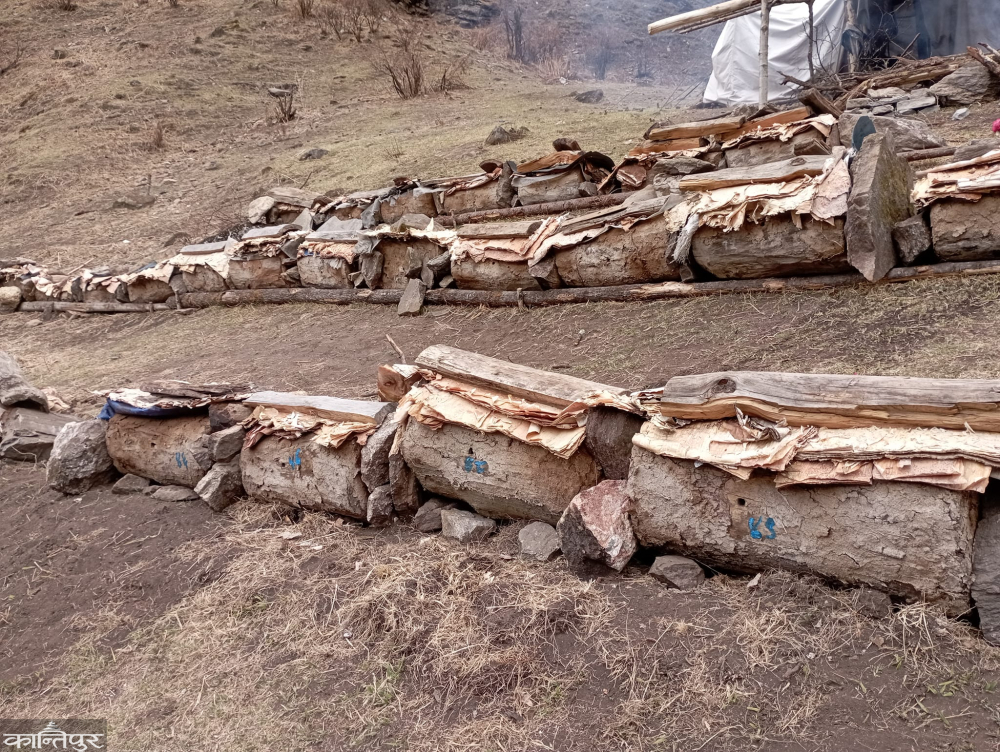Disease threatens beekeeping

We use Google Cloud Translation Services. Google requires we provide the following disclaimer relating to use of this service:
This service may contain translations powered by Google. Google disclaims all warranties related to the translations, expressed or implied, including any warranties of accuracy, reliability, and any implied warranties of merchantability, fitness for a particular purpose, and noninfringement.

Highlights
- Bees leave the hive, can't fly and die, but even after a long time the disease cannot be diagnosed, the farmer is at a loss.



Narayan Chaulagai of Chandannath-4 had 25 hives of bees 5/6 years ago. At least 5 kg of honey was extracted from each hive in a year, which earned him a good income. Now he is earning 1.5 to 2 lakh rupees in a year by keeping 11 hives of bees.

In the last five years, 7 hives of bees died due to disease. He sold 7 beehives at the rate of Rs. Ramakrishna Budhatapa of Chandannath-2 used to bring in five lakh rupees annually by selling honey.
He kept up to 150 hives, now there are only 5 bees in his house. He said that almost half of the bees in the hive were destroyed due to the disease. He said, "Beekeeping is attractive, so I sold a hundred hives of bees for fear of being empty after they started dying." But no one has been able to increase the morale of the farmers. He said that even though beekeeping is encouraged when he sees the honey produced, he wakes up and dies when he sees the death of the bees.
Kailo Aidy of Patarasi-2 was the owner of a hundred apiaries. Almost half of the bees in the hive died due to the disease. He earns 4 to 5 lakhs annually by selling honey and is demanding to save the bees. For the treatment of diseases in bees, they also consulted experts from home remedies. But the disease has not been cured. Like them, hundreds of farmers in the district are suffering from bee dying disease.
Bees leave the hive, can't fly and die. But they say that even after a long period of time, the disease was not diagnosed, so they suffered losses. In Jumla, 'Serana Serana' breed is used for beekeeping. Local farmer Narayan Choulagai said that although the bees of this breed can withstand cold, have less irritation and disease resistance, they are being destroyed by diseases in recent years.
 There is beekeeping in all 60 wards of all the municipalities of Jumla. Jumla honey is taken to Kathmandu, Nepalgunj, Surkhet, Butwal, Chitwan and other cities. Internal and external tourists also buy honey from Koseli shops in the district. Farmers say that the honey produced here has medicinal properties as it grows in the forest and organically. The technical team came four years ago after informing the National Bee Development Center about the disease in bees. The expert team of the Maury Development Center has not yet given a report or any suggestion. Their reports have not been seen or heard," Chaulagai said.
There is beekeeping in all 60 wards of all the municipalities of Jumla. Jumla honey is taken to Kathmandu, Nepalgunj, Surkhet, Butwal, Chitwan and other cities. Internal and external tourists also buy honey from Koseli shops in the district. Farmers say that the honey produced here has medicinal properties as it grows in the forest and organically. The technical team came four years ago after informing the National Bee Development Center about the disease in bees. The expert team of the Maury Development Center has not yet given a report or any suggestion. Their reports have not been seen or heard," Chaulagai said.
There is no government data on beekeeping in the district. But Karnali Beekeeping Cooperative Society Limited Jumla is encouraging farmers to keep bees by providing training and equipment. There are now 8,400 beehives in the district. At least 6 kg of honey is being produced in one hive. "Around 50,000 kg of honey is being produced throughout the district," said Choulagain, who is also the secretary of the cooperative.
Most beekeeping is done in Patarasi and least in Tatopani and Sinja. According to the statistics of the cooperative, the most 1,600 hives are kept in Patarasi, 1,500 in Tila, 1,400 in Guthichaur, 1,200 in Kankasundari, 700 in Hima, 1,000 in Chandannath and 5/500 in Tatopani and Sinja. District Agricultural Development Office, Apple Superzone, Karnali Beekeeping Cooperative and farmers have said that they should sit down and think about the future of beekeeping. They also said that it is sad that there is no program in the field of beekeeping.
Balakram Devkota, head of District Agriculture Development Office Jumla, says that due to the lack of grazing area, the effects of climate change and the use of pesticides in agriculture, there has been a problem in beekeeping. The disease seen in bees has not been detected. But the team of the Bee Development Center has said that the problem is due to human error," he said. "The problem is coming as beekeeping is decreasing due to adverse rains and drought.
 प्रकाशित : श्रावण ७, २०८१ ०७:१८
प्रकाशित : श्रावण ७, २०८१ ०७:१८

 २२.१२°C काठमाडौं
२२.१२°C काठमाडौं











